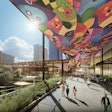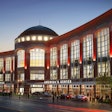As home-based and remote work increase in the United States, traditional business organizations are meeting a rising need for non-traditional workspaces. From chambers of commerce to community groups, many offices are clearing room in their buildings for meeting spaces and opening their doors to local professionals.
In Michigan, the Grand Rapids Area Chamber of Commerce has opened a Work Café for its members. Director of Membership Laura Traxler said the space has helped make chamber members from across the region feel connected.
“What inspired it is the fact that we see so many businesses are home-based, and the members that we serve are spanning pretty far throughout Michigan, so we really felt like we needed an epicenter of business right downtown to attract all of our members,” Traxler says.
The Work Café opened in March 2018, and Traxler said it is now averaging 1,200 visitors every month. It offers an open seating area with free coffee along with private meeting rooms and a conference room that is available for reservations.
Traxler said one of the biggest benefits of the space for members is the “unintentional networking” it drives.
“It gives you the benefit of meeting other people,” Traxler says. “It’s really come to full fruition that people are using it as a space to connect, but then really get their work done.”
Traxler said she is seeing the trend of collaborative work and meeting spaces grow throughout the chamber industry and expects to see it continue.
“As a nation, I do think that the culture is just moving this way, going more remote and going more home-based, which is going to drive the community to have more places like this that people can pop in and work,” Traxler says.
The trend isn’t limited to chambers of commerce. In October 2018, the Southwest Florida Community Foundation in Fort Myers, Florida, opened Collaboratory—a renovated 1920s train depot that is now home to the foundation’s offices, as well as meeting spaces that are open to the community.
Today, Collaboratory offers a wide range of meeting spaces including a board room, a large multipurpose room and an “Idea Room” with a table and white board walls for creative brainstorming. It also has a café-style open seating area for visitors who want a coffee shop feeling in a professional setting.
Owen says she is excited by how consistently Collaboratory being used. She believes the space is popular because of the privacy and technology possibilities it offers compared to other public spaces.
“If you’re having a meeting, say, at a restaurant, it’s impossible to bring up a white board or any kind of technology you need to have,” Owen says. “I think the space allows for that and it allows for you to run into people there. You never know what event might be going on, or who you might meet in Collaboratory.”















